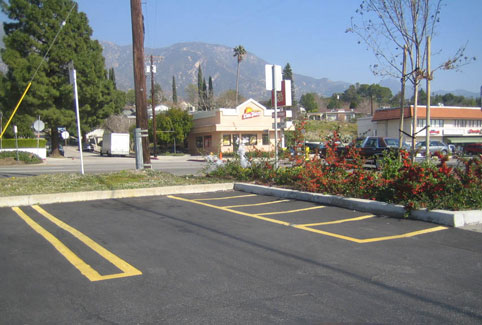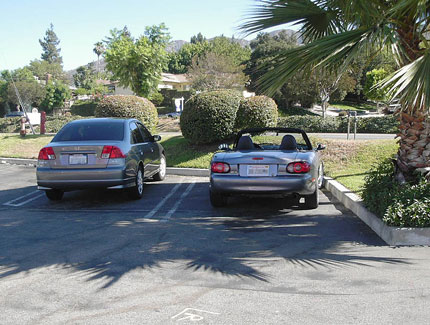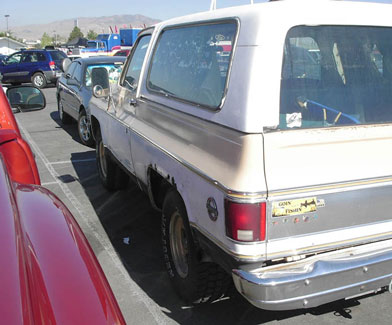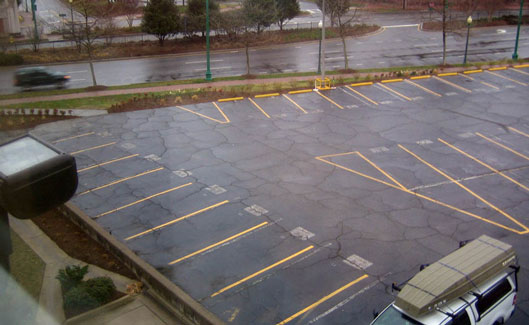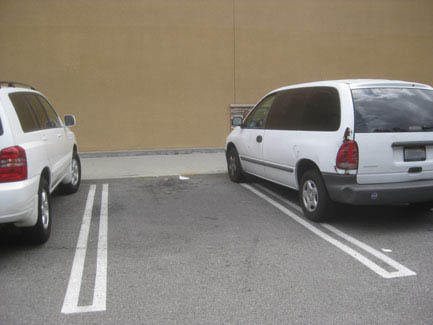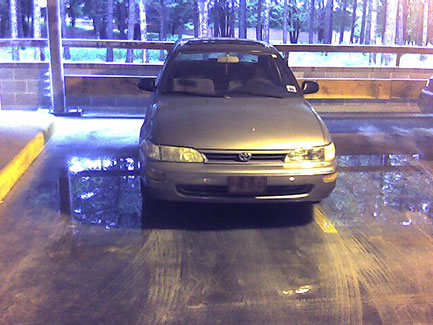Parking By DesignTM
| Step 1: Selection | |
|
As no surprise, the major factor in safe parking is where a vehicle is parked. But choosing a space is more than just finding one that's "out of the way." ScoringEvery parking space can be scored. This is admittedly a very subjective process, but it will provide a scale to help you decide what risks to take. After you start to look at and think about parking space attributes, you won't really need to score spaces - you will intuitively and quickly decide "yes" or "no". 5. Prepared Storage The best resting place for a vehicle is under a car cover in your garage. If you are in earthquake country, all shelving must also be secured to the wall, and shelves should have lips at the edge to prevent items from falling during shakers. (Come to think of it, these are not bad practices anywhere.) Creating a #5 spot for your vehicle requires some planning. A #5 is not really a "parking" space - it's storage. A fenced yard (with no danger of "children damage" of course) would also qualify. 4. The "Great Space" This is a legal parking space in a public area but is situated in such a way as to prevent vehicles from parking next to your vehicle (on most or all sides). While parked here, chances that someone will bump you are remote. A lot of street parking falls into this category, perhaps between two driveways so no one will be pulling into the space in front of, or behind you. In a parking structure, it may be between two pillars. This is the space for which I am constantly on the lookout. (It's sad to spot a space like this only to have some 'beater' sitting in it.) We'll discuss the Great Space in more detail below. 3. The "Bonus Space" This is a legal parking space in a public area but, for one reason or another, includes extra space. If proper techniques are followed utilizing this extra space, chances that someone will bump your vehicle are greatly reduced. (More examples of Bonus Spaces are provided below.) 2. A "Decent Gamble" If no "Great" or "Bonus" spaces are available, and the parking techniques outlined below are used, this is your goal and the minimum I'll usually take. While there is still some risk, I feel relatively safe. Two characteristics of a #2 is that you will not have more than one parking neighbor and the space is large enough to practice good positioning. (More on that on the next page.) 1. A "Bad Bet" This is an average parking space. It may even appear to be a #2 when you park there (i.e. a small car next to it), but circumstances are likely to change before you get back. 0. "No Way" When you must leave a vehicle here, you resign yourself that it is possibly going to be damaged. These spaces will exhibit some, or all, of the following attributes: very narrow or is on a slope; adjacent vehicle is parked over the line (a line violation); neighboring vehicles include big and/or old vehicles in poor condition - you get the idea. If you are willing to pull into in one of these spaces, don't waste your time reading any further. (I wouldn't park a rental car in a #0.) It's very rewarding to return to a #0 or #1 and find no damage. Even when parking here, using some of the techniques on the next page will reduce the risk. In other words, I look for a #4 or at least a #3. If I won't be parking long, I might take a #2. The majority of available parking spaces are either a #1 or #0. For the most part, you should not use neighboring vehicles in calculating the score for a space. Unless you are pretty sure that adjacent vehicles will be parked for an extended period (or, at least, you'll be back before they move) don't gamble - presume the worst. Remember that other parked vehicles will never damage your vehicle. It's the "coming and going" of adjacent vehicles that will cause a problem.
|
| The Selection Technique | |
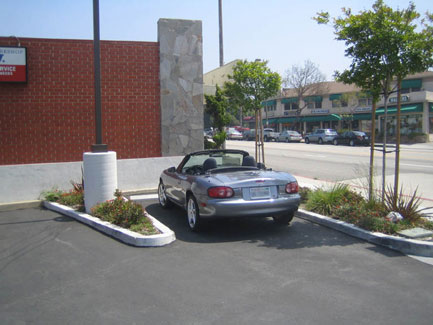 The Great Space |
Plan A - Seek the "Great Space"As discussed above, the Holy Grail or brass ring of parking is what I call the "Great Space." Not every parking lot has one, but there are many around. These are the spaces that seem to be made for paranoid parkers like me - and maybe you. These spaces provide "built-in" protection on both (or all) sides. Perhaps they are surrounded by two concrete pillars. Or a mysterious three-side concrete curb. Because these space are highly prized, they might only available when parking is light. In this case, you might want to reschedule your visit to that location. Of course, as I said, there is no 100% safe space. But I sure feel better about leaving my car between two concrete columns rather than a couple of old rusty pickups. One other thing - sometimes the greatest space in not in the parking lot at all. (More on street parking later.) Click here to see some other Great Spaces
|
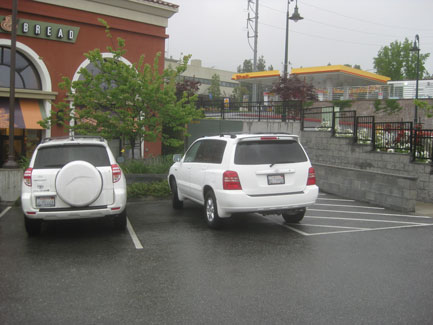 A perfect Bonus |
Plan B - The "Bonus Space"While looking for the Great Space, you should be scanning for Bonus Spaces at the same time. The Bonus Space can usually be identified by a large amount of adjacent space where no one can park. It allows the parker to wisely utilize that space for added space around their vehicle. After looking at the Bonus Space picture, take a look at the (wet) lot in the picture below it. Not a "Great Space" to be found. But can you spot the "Bonus Spaces"? As stated above, by using that extra space next to some parking spaces, you can easily avoid having someone park uncomfortably close. Yes, it's still a gamble. But I think you'll agree that the odds are better than in one of the other spaces. |
| Other Selection Factors | |
|
Your Neighbors - Choose Wisely!With the failure to find a "Great" or "Bonus" space, sooner or later, as you troll through the lot, you're going to soon have to roll the dice, take a chance, and select an average spot, hopefully at least a #2, a "Decent Gamble." If this is the case, then your neighbors and positioning (the following page) becomes more important. Although evaluating who your neighbor will be is an important step, obviously the vehicle in the adjacent space may not be the same one parked there throughout your stay. The risk of having different (and worse) neighbors increases the longer your vehicle is parked, especially if you are at a location in which people come and go often (i.e.: the post office, bank or a 7-Eleven). Having one neighbor is almost always better than two. All else being equal, parking to the extreme 'no-car' side of an end space (next to a bush or a wall as in the photo to the left) will give you 100% protection on that side. There is a small reduction in risk if the one adjacent parking space is to your left. If so, you can pull in far to the right leaving as much room as possible on your driver's side, which is the passenger side of your neighbor. If they don't have a passenger, you have a pretty safe space - unless, of course, a vehicle with a passenger pulls in. OK, you've selected a space. But you're not done. After a potential space is found, use the techniques on the following page to properly situate your vehicle in that space. |



